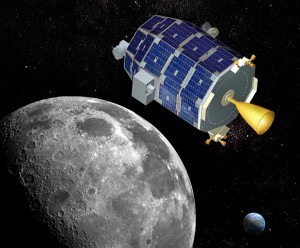
LADEE probe will investigate thin lunar atmosphere and perform laser communications tests (Credits: NASA).
Lunar Atmosphere and Dust Environment Explorer (LADEE) which launched on September 6 atop a Minotaur V rocket, encountered a glitch in its attitude determination system shortly after being separated from the upper stage.
“The really important thing is that we have full communications. Everything is healthy onboard the spacecraft,” said Pete Worden, director of NASA’s Ames Research Center, in a post-launch press conference.
LADEE blasted off from NASA’s Wallops Flight Facility in a flawless night-time launch that was visible along the US East Coast. However, right after the separation from the rocket, LADEE’s onboard computer autonomously shut down the reaction wheels after noticing they were consuming too much current. Reaction wheels are used to stabilize satellites and are crucial especially just after the separation, when they are used to change the attitude of the spacecraft in order to point solar panels towards the sun and establish communications with ground before exhausting the energy of the battery. LADEE is anyway equipped with backup thrusters that can be used to obtain the expected orientation.
“We’re pretty confident that we’re going to get it in the right state,” said Worden, who also added in a press conference on September 7 that “everything is working, and the computer did what it was supposed to do.”
The $280 million LADEE, developed and built at the Ames Research Center, is on a 30-day route to the Moon, where it will measure the extremely thin lunar atmosphere, which is a surface boundary exosphere, from a low lunar orbit. The probe will contribute also to solve the mystery of a strange glow observed by the Surveyor 7 lander in 1968 and by some Apollo astronauts on the moon’s horizon before sunrise. LADEE will test if, as scientists think, it may have been caused by electrically charged moon dust. The probe is also supposed to test laser communication with a short-duration communication payload demonstrator that will be able to transmit six times more data using 25 percent less power than an equivalent radio-frequency system. The laser communication experiment will be carried out during the first 30 days of testing around the moon, and then LADEE will undertake 100 days of science before crashing into the lunar surface after running out of fuel.
In the meantime, NASA engineers are working on a repair plan to fix the glitch that cut off the reaction wheels, this time with no time pressure, because LADEE will take nearly a month before getting to the moon.
Update: It seems that the reaction wheels are now back online, although details of the recovery are not yet available.
Below, LADEE’s liftoff in the night of September 6 (Courtesy of NASA).

















































































































![A trajectory analysis that used a computational fluid dynamics approach to determine the likely position and velocity histories of the foam (Credits: NASA Ref [1] p61).](http://www.spacesafetymagazine.com/wp-content/uploads/2014/05/fluid-dynamics-trajectory-analysis-50x50.jpg)



Leave a Reply